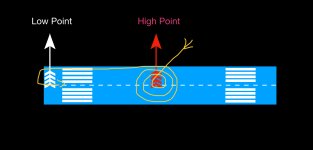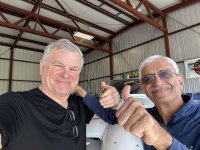CJT
Active Member
I have been trained and been flying high wing Cessna, all the while, hence the need for transition training in RV10, was imperative and also needed requirement for insurance
Being located in Maryland, I started searching for transition training on east coast and chanced upon Van’s east coast representative Zack Czachorowski at New Garden airport N57. Needing five hours of training required two days.
Zack is an amazing personality, warm, knowledgeable, highly experienced pilot, builder, instructor, having military and airline experience. In few minutes he put me at ease with his warm mannerism.
The first part of morning was devoted to understanding the differences between training aircrafts and high performance, sleek beauty RV 10. Followed by planning of flight training steps.
On climbing into the aircraft you notice the beauty of huge windscreen and windows giving you excellent field of vision. Flying with stick appeared more intuitive and natural compared to yoke, with added advantage of lack of obstruction of instrument panel, so common with yoke.
Taxiing initially is challenging because of free castering nose wheel, and one tends to ride the brakes, but with conscious effort, one can easily overcome it.
With amazing climb performance, very light control inputs, superb turning ability and short landing distance, this aircraft is like a sleek sports car
Right from the word go, Zack handed me the controls and with his excellent comminution skills and art of making student comfortable, inspired confidence.
The best part of learning was short field landing at an airport with trees at the end of runway and his technique of handling engine failure, which no one had taught me so well till now
He broke it down to;
MAC ( maintain aircraft control, essentially trim to best glide speed of 85KT)
AS ( Analyze systems, by transferring fuel tank, rich mixture, alternate air, battery, alternator and cranking the engine)
TPA ( Take proper action, by announcing emergency, squawking code, planning smooth and safe landing), if you happen to be over an airfield, to circle around the high point on the center of the field to transition from cruise altitude to above the pattern altitude, fly the downwind leg to low point at the runway threshold aiming to reach it at the pattern altitude and plan smooth transition to descent and land
I feel every RV builder must take transition training to understand the handling characteristics, and if you happen to be on east coast, go to Zack.
Being located in Maryland, I started searching for transition training on east coast and chanced upon Van’s east coast representative Zack Czachorowski at New Garden airport N57. Needing five hours of training required two days.
Zack is an amazing personality, warm, knowledgeable, highly experienced pilot, builder, instructor, having military and airline experience. In few minutes he put me at ease with his warm mannerism.
The first part of morning was devoted to understanding the differences between training aircrafts and high performance, sleek beauty RV 10. Followed by planning of flight training steps.
On climbing into the aircraft you notice the beauty of huge windscreen and windows giving you excellent field of vision. Flying with stick appeared more intuitive and natural compared to yoke, with added advantage of lack of obstruction of instrument panel, so common with yoke.
Taxiing initially is challenging because of free castering nose wheel, and one tends to ride the brakes, but with conscious effort, one can easily overcome it.
With amazing climb performance, very light control inputs, superb turning ability and short landing distance, this aircraft is like a sleek sports car
Right from the word go, Zack handed me the controls and with his excellent comminution skills and art of making student comfortable, inspired confidence.
The best part of learning was short field landing at an airport with trees at the end of runway and his technique of handling engine failure, which no one had taught me so well till now
He broke it down to;
MAC ( maintain aircraft control, essentially trim to best glide speed of 85KT)
AS ( Analyze systems, by transferring fuel tank, rich mixture, alternate air, battery, alternator and cranking the engine)
TPA ( Take proper action, by announcing emergency, squawking code, planning smooth and safe landing), if you happen to be over an airfield, to circle around the high point on the center of the field to transition from cruise altitude to above the pattern altitude, fly the downwind leg to low point at the runway threshold aiming to reach it at the pattern altitude and plan smooth transition to descent and land
I feel every RV builder must take transition training to understand the handling characteristics, and if you happen to be on east coast, go to Zack.






